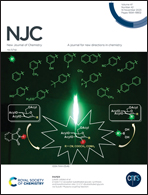Copper(i) iodide coordination polymers with triazole substituted pyridine ligands: photophysical and electrical conductivity properties†
Abstract
This work aims to synthesize multifunctional materials with tunable emission properties. To pursue this, three isomeric ligands; 2-(1H-1,2,4-triazol-1-yl)pyridine (L1), 3-(1H-1,2,4-triazol-1-yl)pyridine (L2) and 4-(1H-1,2,4-triazol-1-yl)pyridine (L3) were reacted with CuI to afford three different coordination polymers, [Cu2(μ3-I)2(L1)2]nCP1, [Cu2(μ2-I)2(L2)2]nCP2 and [Cu(μ2-I)(L3)]nCP3, respectively. CP1 consists of a 1D chain comprising double-stranded Cu2I2 secondary building units (SBUs), where each copper is coordinated with the triazolyl nitrogen of the ligand on each side of the chain while the pyridine nitrogen remains pendant. Contrary to this, both pyridine and triazolyl nitrogens of L2 and L3 coordinate to Cu to give 1D and 2D CP2 and CP3, respectively. CP2 has a discrete Cu2I2 rhomboid SBU bridged by two L2 ligands, whereas CP3 has Cu–I single chains bridged by two L3 ligands to give a 2D sheet structure. All three coordination polymers are emissive at room temperature with the emission colour varying from green and yellow to orange with a λmax of 538, 575 and 600 nm, respectively for CP1 to CP3. CP1 and CP3 show luminescence thermochromism on lowering the temperature from 298 K to 77 K, changing hues from green to blue and orange to yellow, respectively. In addition to unique emission properties, these CPs exhibit semiconductor behaviour, with electrical conductivity in the range of 10−7 S cm−1. It is proposed that the presence of the Cu2I2 double-stranded chain provides a better and continuous overlap of copper and iodine orbitals, giving better conductivity to CP1 compared to CP2 and CP3.



 Please wait while we load your content...
Please wait while we load your content...